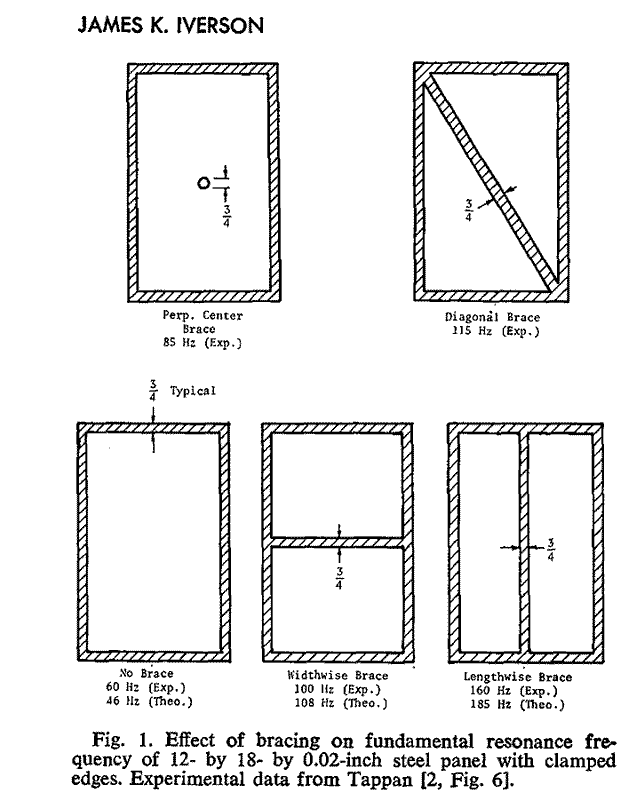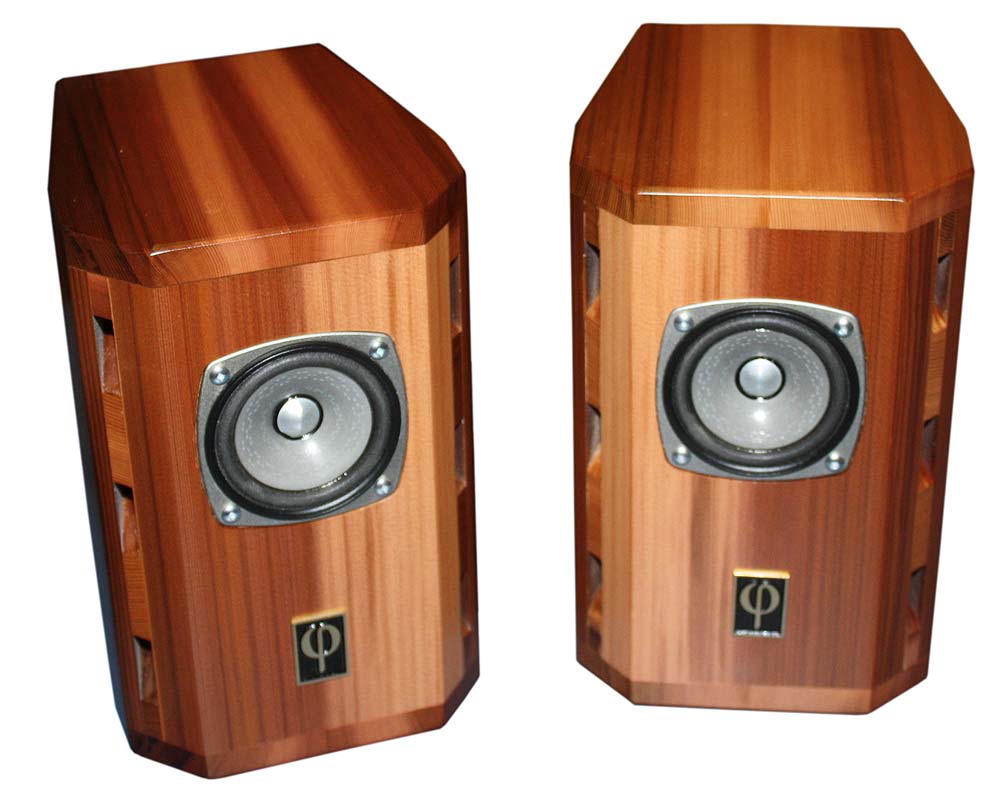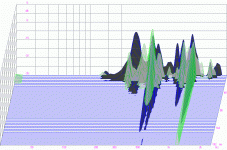By adding bracing you divide the panel in much smaller panels that vibrate much less and also higher in frequency.

dave
...some nice thick carpet underlay...
Stuff that is made from natural materials is much better damping than teh plastic stuff.
dave
...they could kill all the vibrations in the lower frequency area but they would end up with vibrations at higher frequencies which would last much longer and all give a loudspeakers with an unpleasant sound.
Every material vibrates. Music rarely has frequency content high enuff in frequency and those notes are even less rarely continuous enuff to inject sufficient energy to get it going.
I don’t read French, so don’t know what excitation they used, but the one chart shows resonances well below 500 Hz.
That is not high enuff.
dave
Stuff that is made from natural materials is much better damping than the plastic stuff.
dave
This stuff is what is available to me, I'm going to stuff the cabinets with wool which should help.
Original in Dutch
Plywood vrs MDF (modestly braced) from that paper (ignore the colours, i inverted them). Note how high the lowest resonance is.
dave
Attachments
Plywood is the green ?
At least from the enclosure bracing pictures, the no bracing one seems ok if it resonates at 60 hz... the boxy sound is something between 100 hz and 300 hz, correct ? While I assue you must deal with harmonics : so 120 hz, then 240 hz : in the middle of the boxy sound frequencies ! Well maybe the stuffing is lowering enough the spl level of those harmonics ?!
But what I'm learning right now is no bracing gives very shaking cabinet walls , at least in my 0.4" / 1 cm plywood ! Despite they are all stuffed with 0.5 cm rubber walls glued with neoprene !
At least from the enclosure bracing pictures, the no bracing one seems ok if it resonates at 60 hz... the boxy sound is something between 100 hz and 300 hz, correct ? While I assue you must deal with harmonics : so 120 hz, then 240 hz : in the middle of the boxy sound frequencies ! Well maybe the stuffing is lowering enough the spl level of those harmonics ?!
But what I'm learning right now is no bracing gives very shaking cabinet walls , at least in my 0.4" / 1 cm plywood ! Despite they are all stuffed with 0.5 cm rubber walls glued with neoprene !
Last edited:
The BBC approach was to push things down below 100 Hz. Works OK full-range sometimes, works well in things like waxx’s midTweeter box in his big WAW.
dave
dave
Poplar is easy to get here. Quite cheaper than birch or beech (about 20% cheaper). Very light but it's a tender wood, it is easily marked in case of shocks. Maybe as part of a sandwich?
that's what I did. poplar has a Young modulus around 360, so a very good wood for damping, Balsa being the king. But yes fragile and light (that's why he was used for the mail-coach or trunk and traveling coach like Vuitons'.
The one I bought is hard enough outside cause the eucalyptus outside (see the pictures in this thread)... that is harder but still have a low Young Modulus, very near from the poplar . Look at Dispano.
Yep, I think it would be even better glued with a stiffer wood inside the cabinet. constrained layers
I'm thinking about 100% poplar 2 cm ply for the front baffle, but decoupled with a 4 mm rubber seal with no screw or with screw but the drivers with no screw (but the one behind à la Nautilus !)
My understanding is the better damping of a soft wood or material avoid the external wall to act as a drivr itself : the more the damping the less spl it is outputting !
I'm looking 2 cm industrial rubber in panels but don't find it... sourcing is a plain job ! Inside in the picture I use rubber carpet for washing machines : 0.5 to 1 cm thick, cheap enough ... mostly for damping the high energy of low frequencies (mid-woof) as I don't beleive foam is working with those wavelengths and spl (foam and wool is for the bracing of the mid wavelength as far I try to understand it)
The one I bought is hard enough outside cause the eucalyptus outside (see the pictures in this thread)... that is harder but still have a low Young Modulus, very near from the poplar . Look at Dispano.
Yep, I think it would be even better glued with a stiffer wood inside the cabinet. constrained layers
I'm thinking about 100% poplar 2 cm ply for the front baffle, but decoupled with a 4 mm rubber seal with no screw or with screw but the drivers with no screw (but the one behind à la Nautilus !)
My understanding is the better damping of a soft wood or material avoid the external wall to act as a drivr itself : the more the damping the less spl it is outputting !
I'm looking 2 cm industrial rubber in panels but don't find it... sourcing is a plain job ! Inside in the picture I use rubber carpet for washing machines : 0.5 to 1 cm thick, cheap enough ... mostly for damping the high energy of low frequencies (mid-woof) as I don't beleive foam is working with those wavelengths and spl (foam and wool is for the bracing of the mid wavelength as far I try to understand it)
Last edited:
Very light but it's a tender wood, it is easily marked in case of shocks.
Same issue with Western Red Cedar which turns out to be a good cabinet material but suffers from the same issue. Penetrating expoxy?

dave
- Home
- Design & Build
- Construction Tips
- Why it is important to avoid construction grade plywood
